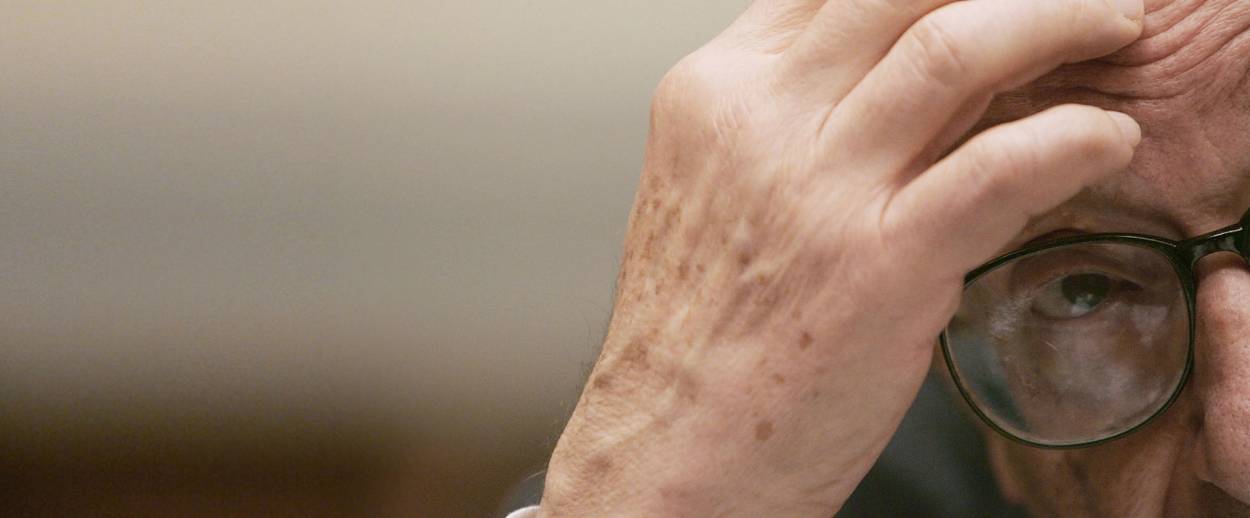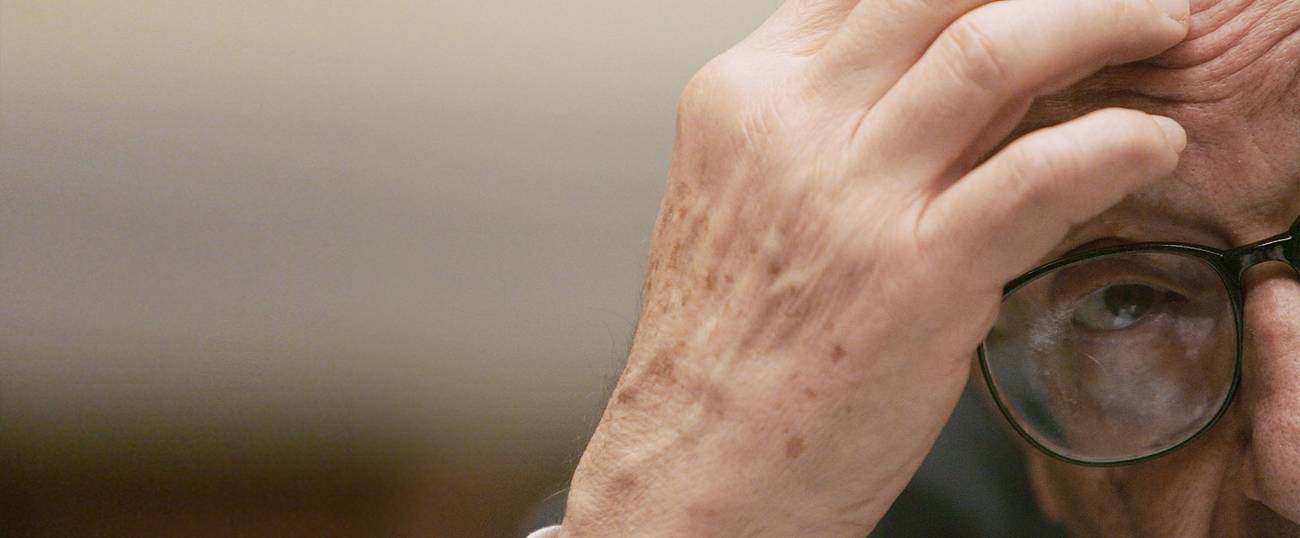The Jew Who Killed the Banks?
Alan Greenspan: genius or villain? A new biography, ‘The Man Who Knew,’ prosecutes and praises the conductor of a wild market ride




Few public figures have seen their reputations change as quickly and dramatically as Alan Greenspan. When he stepped down as chairman of the Federal Reserve Bank in 2006, Greenspan was widely regarded as, in the words of one team of admiring economists, “the greatest central banker who ever lived.” He was the man who had guided the nation’s financial system through two decades of prosperity, managing to deliver a seemingly impossible combination of low inflation, low interest rates, and low unemployment. And he had demonstrated equal mastery of the political system, serving four terms as Fed chairman under presidents of both parties, while winning the adulation of Congress and the press. In his new biography of Greenspan, The Man Who Knew, Sebastian Mallaby notes that in 2006 an artist named Erin Crowe put on a show featuring 30 portraits of Greenspan, which sold for $6,000 apiece. Try doing that with Paul Volcker or Janet Yellen.
Two years after Greenspan’s retirement, however, came the financial crisis of 2008, the worst shock to the American financial system since the Great Depression. The rising tide of prosperity during the Greenspan years—or at least during the last five years of his term—was revealed to have been a bubble all along. Low interest rates led to a vast inflation of the value of real estate, and homeowners, dizzy with paper wealth, spent freely, thus keeping the economy booming. Thanks to lax regulation of the subprime mortgage industry, it was easier than ever for people to become homeowners, even when that meant taking out loans they could never pay back. But when house prices began to decline, the whole tower of debt came falling down, wiping out venerable Wall Street institutions like Bear Stearns and Lehman Brothers, and requiring massive government bailouts of banks and insurance companies that were considered “too big to fail.” Even eight years later, our politics are still affected by the anger and confusion generated in a few days in the fall of 2008.
Suddenly, the question about Greenspan changed from how he did it to why he didn’t know what was coming. That is the issue that dominates Mallaby’s long (almost 700 pages), thorough, and hardheaded biography. If Mallaby, an eminent financial journalist, had written his book in 2006, it would have had to be a hagiography; in 2016, it is something between a prosecutor’s brief and an inquest. This is not to say that Mallaby is relentlessly or unfairly critical. On the contrary, he obviously respects Greenspan and sees him as a gifted economic forecaster, who on several occasions made counterintuitive judgments that proved to be spectacularly right. Greenspan does indeed deserve a share of the credit for those two decades of growth; by the same token, he can’t escape a share of the blame for what followed.
***
The subtitle of The Man Who Knew is “The Life and Times of Alan Greenspan,” and though the book takes the form of a biography, the emphasis is much more on the times than the life. That is only appropriate, because in Mallaby’s telling, the key fact about the private Greenspan is that there is no there there. His recessive personality leads Mallaby to refer to him often as “the sideman,” a nickname drawn from his early experience playing saxophone in a big band. This sounds like an adventure, but in the recollection of other members of the Henry Jerome Band, the 18-year-old Greenspan was known as “a better bookkeeper than musician,” often called upon to do his colleagues’ tax returns. After a few months of this life, he quit to go back to college in economics, and it was economics all the way after that.
Greenspan’s withdrawn, often inscrutable personality turned out to be perfect for a central banker, whose perceived moods could move markets around the world. But it originated, Mallaby writes, in an unhappy childhood. Born in 1926 in Washington Heights, Greenspan was the son of ill-matched parents who quickly divorced. His father played little role in his childhood, and the man’s serial business failures seem to have given Alan a lasting contempt for him. It was his mother, Rose, who dominated his life, and continued to do so for a very long time: She lived to be 92, and as an adult, Greenspan called her every morning. It wasn’t until after her death that he finally married his longtime companion, the TV news reporter Andrea Mitchell.
‘It’s really difficult not to get along with Alan Greenspan. He doesn’t give off enough emotional content for you to be offended.’
Greenspan and women is one of the more interesting enigmas in Mallaby’s book, but it remains largely unsolved. After a brief early marriage that ended in divorce, Greenspan spent decades as one of Washington’s most eligible bachelors, and dated many high-profile women, including Barbara Walters. But most of these relationships dissolved without acrimony, as if there was never much emotion involved, and few of the women seem to have revealed much to Greenspan’s biographer. One of his longtime colleagues in his private consulting business, Kathryn Eickhoff, may have captured the secret when she said, “It’s really difficult not to get along with Alan. He doesn’t give off enough emotional content for you to be offended.” Handsome, powerful, and undemanding, he was an ideal companion for an ambitious Washington woman.
But the real love story in The Man Who Knew is the one between Alan Greenspan and power. He started out in the 1950s as a consultant, running a small firm that offered economic forecasts to corporate clients. Greenspan thrived in this role, thanks to his instinct for making mountains of data yield useful conclusions. Based on, say, scrap-metal prices, he could predict the movement of whole industries and markets. The business made him a good living, but not a fortune; ironically, for a man who knew so much about money, he was never singlemindedly devoted to acquiring it. He was much more interested in ideas, and in the early 1950s he made the acquaintance of the novelist Ayn Rand, who briefly turned him into a disciple. As a so-called Objectivist, Greenspan was, in principle, absolutely committed to free-market capitalism. He advocated a return to the gold standard, an end to antitrust litigation—monopolies, he argued, were actually good things—and a pure laissez-faire approach to economics.
To retain these ideas in their pure form, however, Greenspan would have had to remain, like Rand, a cultish, crankish figure. Once opportunity came knocking, in the shape of an invitation to advise Richard Nixon’s 1968 campaign, Greenspan was ready to open the door. Mallaby shows that, in the next phase of his career—which included service to the Ford administration, as chairman of the Council of Economic Advisers, and the Reagan administration, as a member of a commission on Social Security reform—Greenspan proved himself to be highly pragmatic, the opposite of a Randian ideologue. When President Ford wanted to cut taxes, Greenspan knew it was the wrong move economically, but he went along and endorsed it. And when Greenspan did stick to his guns, advising Ford not to bail out New York City during its debt crisis in 1975, he found that politics prevailed anyway: After an initial refusal, Ford did come to the city’s rescue.
The lessons he learned during this period, Mallaby shows, informed his tenure as chief of the Federal Reserve Bank, starting in 1987. For the next 19 years, Greenspan was at the heart of financial decision-making for the United States, and for long stretches The Man Who Knew reads less like a biography than an economic history. Mallaby shows how Greenspan reacted to the market crash of 1987, the recession of 1991, the Clinton deficit-reduction plan, the boom years of the mid-1990s, the Long Term Capital Management blow-up of 1998, and the uncertainty following Sept. 11.
Greenspan worked against the politicians on more than a few occasions—refusing to cut interest rates to help George H.W. Bush win reelection in 1992, for instance. But more often he found ways to accommodate the politicians’ plans, even when it went against his free-market convictions. The details of financial policy in The Man Who Knew are fairly involved, and require at least some background in economics to follow fully. But one theme that emerges clearly is that even when Greenspan’s ideology called for the government to abstain from action—and even when inaction really might be the best course—it was politically impossible for elected officials not to do something to tinker with the economy. And because the economy is a vast, interconnected system, every intervention has unintended results. Cut interest rates to increase employment, and inflation starts to rise; raise them to fight inflation, and companies stop hiring new workers. There is no permanent solution to financial policy, only an endless series of adjustments.
As much for intellectual as for practical reasons, Greenspan believed the best thing was to let the market take its own course, and let the consequences sort themselves out, as in a perfectly rational system they would. But he reconciled himself to the fact that American politics and economics are far from rational. This is especially true in moments of crisis, and Mallaby shows how the government’s record of intervening at such moments led the markets to believe that big banks and brokerages would never be allowed to fail. This confidence enabled risky investments (like subprime mortgages) that, Greenspan believed, the free market should be too intelligent to make. Mallaby leaves the reader with the impression that, despite his enormous reputation, Greenspan was never steering the economy, so much as he was riding it like a bucking bronco. And if Alan Greenspan is helpless in the face of economic forces, how much more so are the rest of us?
***
Adam Kirsch wrote about a pair of Polish war memoirs for the latest issue of Tablet’s print magazine. Subscribe here.
Adam Kirsch is a poet and literary critic, whose books include The People and the Books: 18 Classics of Jewish Literature.